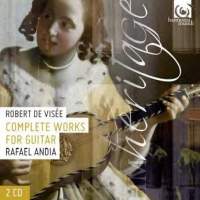Texte paru dans: / Appeared in: |
|
|
Outil de traduction ( |
|
|
|
|
|
Reviewer: Edward
Strickland The CD is a 60:30 set of excerpts from the three-LP set, offering more than 40% of its material. Although the set does not mention digital recording, the CD bears the familiar tri-ple-D brand on its rear. Robert de Visée taught Louis XIV guitar and often serenaded the king to sleep. More importantly, he was one of the great masters of composition for plucked instruments in the French Baroque, instrumental in the overthrow of the stately (and native) lute by the foreign upstarts theorbo and guitar, from Italy and Spain respectively. Four years ago I received an Astrée disc of Hopkinson Smith's performances of the theorbo works, the melancholy tone of which I found irresistible. The Harmonia Mundi recording, in both CD and LPs, is equal to the excellent engineering of the Astrée, but I have to confess a prejudice against the Baroque guitar in terms of timbre. The instrument, of course, is considerably smaller than the modern guitar, and I find its tone just thin enough to wear on me after 10 minutes or so. The interpreter, however, is more than commendable, and his commitment to the music is evident throughout. As compared to the theorbo works, these are lighter in spirit, blither and less ponderous for the most part, with moments of ruminative relief in the Sarabandes, Passacailles, and elsewhere. Most of these works were published in two books in 1682 and 1686, but the composition of many far predate those publications. Others were drawn from manuscripts by Andia, who rejected works he regarded as obviously falsely attributed, dubious in authenticity, or error-ridden. The completed suites indicate the extent to which the ordering of movements had yet to be standardized in the mid-Baroque: the Preludes are generally followed by the usual Alle-mande-Courante(s)-Sarabande, but the Gigues (and/or Passacailles) tend to be placed immediately afterwards, with the galanteries last, rather than framed by the Sarabande and Gigue. Specialists will want the three discs. For most, the CD will fill the bill under de Visée, when coupled with the Smith theorbo program. | |
|
|
|
|
|
|
|
Cliquez l'un ou l'autre
bouton pour découvrir bien d'autres critiques de CD |
|



